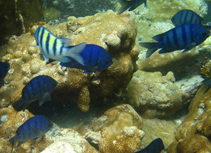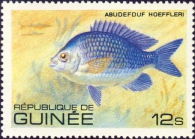WoRMS taxon details
Abudefduf hoefleri (Steindachner, 1881)
273699 (urn:lsid:marinespecies.org:taxname:273699)
accepted
Species
Chromis bicolor (Rochebrune, 1880) · unaccepted
Gliphydodon hoefleri Steindachner, 1881 · unaccepted (misspelling)
Glyphidodon hoefleri Steindachner, 1881 · unaccepted
Heliastes bicolor Rochebrune, 1880 · unaccepted (ambiguous synonym)
marine, brackish, fresh, terrestrial
Not documented
Froese, R. and D. Pauly. Editors. (2024). FishBase. Abudefduf hoefleri (Steindachner, 1881). Accessed through: World Register of Marine Species at: https://www.marinespecies.org/aphia.php?p=taxdetails&id=273699 on 2024-04-18
Date
action
by
![]() The webpage text is licensed under a Creative Commons Attribution-Noncommercial 4.0 License
The webpage text is licensed under a Creative Commons Attribution-Noncommercial 4.0 License
additional source
Froese, R. & D. Pauly (Editors). (2023). FishBase. World Wide Web electronic publication. version (02/2023)., available online at https://www.fishbase.org [details]
ecology source Looby, A.; Erbe, C.; Bravo, S.; Cox, K.; Davies, H. L.; Di Iorio, L.; Jézéquel, Y.; Juanes, F.; Martin, C. W.; Mooney, T. A.; Radford, C.; Reynolds, L. K.; Rice, A. N.; Riera, A.; Rountree, R.; Spriel, B.; Stanley, J.; Vela, S.; Parsons, M. J. G. (2023). Global inventory of species categorized by known underwater sonifery. <em>Scientific Data.</em> 10(1). (look up in IMIS), available online at https://doi.org/10.1038/s41597-023-02745-4 [details]
ecology source Looby, A.; Erbe, C.; Bravo, S.; Cox, K.; Davies, H. L.; Di Iorio, L.; Jézéquel, Y.; Juanes, F.; Martin, C. W.; Mooney, T. A.; Radford, C.; Reynolds, L. K.; Rice, A. N.; Riera, A.; Rountree, R.; Spriel, B.; Stanley, J.; Vela, S.; Parsons, M. J. G. (2023). Global inventory of species categorized by known underwater sonifery. <em>Scientific Data.</em> 10(1). (look up in IMIS), available online at https://doi.org/10.1038/s41597-023-02745-4 [details]
 Present
Present  Present in aphia/obis/gbif/idigbio
Present in aphia/obis/gbif/idigbio  Inaccurate
Inaccurate  Introduced: alien
Introduced: alien  Containing type locality
Containing type locality
From regional or thematic species database
Introduced species vector dispersal Maltese part of the Mediterranean Sea - Eastern Basin (Marine Region) Unlike most of the alien fish species noted in the Mediterranean which have entered through the Suez Canal (Occhipinti-Ambrogi et al., 2011; Kalogirou et al. 2012; Golani et al., 2010; Golani et al., 2014; Vella et al., 2015b), this new alien species has probably entered through the Strait of Gibraltar, given that its typical range is of tropical eastern Atlantic origin (Loris & Rucabado 1990; Edwards et al., 2001; Cowman & Bellwood, 2013). The lack of records of A. hoefleri in other regions of the Mediterranean Sea might indicate that this species is not a natural migrant but has been introduced through shipping activity, especially given that the occurrence of this species has been noted to coincide with the presence of port activities and oil platforms in the Canary Islands (Triay-Portella et al., 2015). [details]
To Barcode of Life (1 barcode)
To Biodiversity Heritage Library (1 publication)
To Biodiversity Heritage Library (1 publication) (from synonym Chromis bicolor (Rochebrune, 1880))
To Biodiversity Heritage Library (2 publications) (from synonym Glyphidodon hoefleri Steindachner, 1881)
To European Nucleotide Archive (ENA)
To FishBase
To FishBase (from synonym Chromis bicolor (Rochebrune, 1880))
To FishBase (from synonym Glyphidodon hoefleri Steindachner, 1881)
To FishBase (from synonym Gliphydodon hoefleri Steindachner, 1881)
To FishBase (from synonym Heliastes bicolor Rochebrune, 1880)
To FishBase images (Abudefduf hoefleri, Cape Verde, by Wirtz, P.)
To GenBank (11 nucleotides; 10 proteins)
To GenBank (11 nucleotides; 10 proteins) (from synonym Glyphidodon hoefleri Steindachner, 1881)
To IUCN Red List (Data Deficient)
To ITIS
To Biodiversity Heritage Library (1 publication)
To Biodiversity Heritage Library (1 publication) (from synonym Chromis bicolor (Rochebrune, 1880))
To Biodiversity Heritage Library (2 publications) (from synonym Glyphidodon hoefleri Steindachner, 1881)
To European Nucleotide Archive (ENA)
To FishBase
To FishBase (from synonym Chromis bicolor (Rochebrune, 1880))
To FishBase (from synonym Glyphidodon hoefleri Steindachner, 1881)
To FishBase (from synonym Gliphydodon hoefleri Steindachner, 1881)
To FishBase (from synonym Heliastes bicolor Rochebrune, 1880)
To FishBase images (Abudefduf hoefleri, Cape Verde, by Wirtz, P.)
To GenBank (11 nucleotides; 10 proteins)
To GenBank (11 nucleotides; 10 proteins) (from synonym Glyphidodon hoefleri Steindachner, 1881)
To IUCN Red List (Data Deficient)
To ITIS

